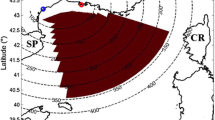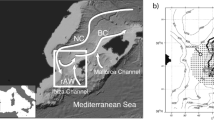Abstract
In order to address the need for surface trajectory forecasts following deployment of coastal HF radar systems during emergency-response situations (e.g., search and rescue, oil spill), a short-term predictive system (STPS) based on only a few hours data background is presented. First, open-modal analysis (OMA) coefficients are fitted to 1-D surface currents from all available radar stations at each time interval. OMA has the effect of applying a spatial low-pass filter to the data, fills gaps, and can extend coverage to areas where radial vectors are available from a single radar only. Then, a set of temporal modes is fitted to the time series of OMA coefficients, typically over a short 12-h trailing period. These modes include tidal and inertial harmonics, as well as constant and linear trends. This temporal model is the STPS basis for producing up to a 12-h current vector forecast from which a trajectory forecast can be derived. We show results of this method applied to data gathered during the September 2010 rapid-response demonstration in northern Norway. Forecasted coefficients, currents, and trajectories are compared with the same measured quantities, and statistics of skill are assessed employing 16 24-h data sets. Forecasted and measured kinetic variances of the OMA coefficients typically agreed to within 10–15%. In one case where errors were larger, strong wind changes are suspected and examined as the cause. Sudden wind variability is not included properly within the STPS attack we presently employ and will be a subject for future improvement.














Similar content being viewed by others
References
Abascal AJ, Castanedo S, Medina R, Losada IJ, Alvarez-Fanjul E (2009) Application of HF radar currents to oil spill modeling. Mar Pollut Bull 58:238–248
Barrick DE, Evans MW, Weber BL (1977) Ocean surface currents mapped by radar. Science 198:138–144
Barrick DE (1979) A coastal radar system for tsunami warning. Remote Sensing Environ 8:353–358
Breivik Ø, Sætra Ø (2001) Real-time assimilation of HF radar currents into a coastal ocean model. J Mar Syst 28:161–182
Frolov S, Paduan J, Cook M, Bellingham J (2011) Improved statistical prediction of surface currents based on historic HF-Radar observations. Ocean Dynamics—Special Issue: SAR2011
Kaplan DM, Lekien F (2007) Spatial interpolation and filtering of surface current data based on open-boundary modal analysis. J Geophys Res 112(C12007), 20 pp
Kjelaas A, Whelan C, Lilleboe P, Fernandez Lopez V, Breivik Ø (2011) Rapid deployable HF Radar for oil spill response. Final report, Norwegian Clean Seas Association (NOFO) Oil Spill Response 2010 Technology Development Program
Lekien F, Coulliette C (2004) Open-boundary modal analysis: Interpretation, extrapolation, and filtering. J Geophys Res 109(C12004), 13 pp
Lekien F, Gildor H (2009) Computation and approximation of length scales of harmonic modes with application to the mapping of surface currents in the Gulf of Eilat. J Geophys Res 114(C06024), 24 pp
Lipphardt BL Jr, Kirwan AD Jr, Grosch CE, Lewis JK, Paduan JD (2000) Blending HF radar and model velocities in Monterey Bay through normal mode analysis. J Geophys Res 105(C2):3425–3450
Lipa BJ, Barrick DE (1983) Least-squares methods for the extraction of surface currents from CODAR crossed-loop data: application at ARSLOE. IEEE J Oceanic Engr OE8:226–253
Lipa BJ, Barrick DE (1986) Extraction of sea state from HF radar sea echo: mathematical theory and modeling. Radio Science 21:81–100
Lipa B, Barrick D, Saitoh SI, Ishikawa Y, Awaji T, Largier J, Garfield N (2011) Japan Tsunami Current Flows Observed by HF Radars on Two Continents. Remote Sensing 3:1–17
O’Donnell JD, Ullman MS, Howlett E, Fake T, Hall P, Tatsu I, Edwards C, Anderson E, McClay T, Kohut J, Allen A, Lester S, Lewandowski M (2005) Integration of Coastal Ocean Dynamics Applications Radar (CODAR) and Short-Term Prediction System (STPS) surface current estimates into the Search and Rescue Optimal Planning System (SAROPS). U.S. Coast Guard Tech. Rep., DTCG39-00-D- R00008/HSCG32-04-J-100052
Oke PR, Allen JS, Miller RN, Egbert GD, Kosro PM (2002) Assimilation of surface velocity data into a primitive equation coastal ocean model. J Geophys Res 107(C9):3122. doi:10.1029/2000JC000511
Paduan J, Shulman I (2004) HF radar data assimilation in the Monterey Bay area. J Geophys Res 109(CO7S09). doi:10.1029/2003JC001949
Pawlowicz R, Beardsley B, Lentz S (2002) Classical tidal harmonic analysis including error estimates in MATLAB using T_TIDE. Comput Geosci 28:929–937
Reistad M, Breivik Ø, Haakenstad H, Aarnes OJ, Furevik BR, Bidlot J (2011) A high-resolution hindcast of wind and waves for the North Sea, the Norwegian Sea, and the Barents Sea. J Geophys Res 116:C05019. doi:10.1029/2010JC006402
Roarty HJ, Lemus ER, Handel E, Barrick DE, Isaacson J (2011) Performance evaluation of SeaSonde high-frequency radar for vessel detection. Marine Tech Soc J 45(3):14–24
Ullman DJ, O'Donnell CE, Fake T, Morschauser D, Sprague M, Allen A, Krenzien LCDR B (2003) Use of Coastal Ocean Dynamics Applications Radar (CODAR) technology in U.S. Coast Guard search and rescue planning. Final report no. CG-D-09-03, U.S. Coast Guard Research and Development Center.
Ullman DS, O'Donnell J, Kohut J, Fake T, Allen A (2006) Trajectory prediction using HF radar surface currents: Monte Carlo simulations of prediction uncertainties. J Geophys Res 111:14, C12005
Zelenke BC (2005) An empirical statistical model relating winds and ocean surface currents: Implications for short-term current forecasts, M.Sc. thesis, Oregon State University, Corvallis, OR
Acknowledgments
The data used in this investigation were collected during the 2010 Rapidly Deployable HF Radar demonstration in Finnmark, Norway by the Norwegian company CodarNor AS with funding from the Norwegian Clean Seas Association for Operating Companies (NOFO) and Innovation Norway through an industrial research and development contract. The Norwegian field work also received funding from the Oilwave project funded by ENI and the Research Council of Norway (NFR) through the PETROMAKS programme (grant no 207541) and from the Biowave project funded through the NFR programme “Havet og kysten” (grant no. 196438). V. Fernández and M.I. Ferrer hold the Torres Quevedo Grant no’s. PTQ06-02-0930 and PTQ09-02-01454, awarded by the Spanish Ministry of Science and Innovation, by the European Regional Development Fund, and by the European Social Fund. The authors would like to personally thank Dr. Anton Kjelaas of CodarNor, Andres Alonso Martirena and Pedro Agostinho of Qualitas REMOS, Peter Lilleboe of CODAR Ocean Sensors, and Jørn Johansen of Polarbase AS for their invaluable contributions to this article and the success of the NOFO field trial.
Author information
Authors and Affiliations
Corresponding author
Additional information
Responsible Editor: Michel Olagnon
This article is part of the Topical Collection on Advances in Search and Rescue at Sea
Rights and permissions
About this article
Cite this article
Barrick, D., Fernandez, V., Ferrer, M.I. et al. A short-term predictive system for surface currents from a rapidly deployed coastal HF radar network. Ocean Dynamics 62, 725–740 (2012). https://doi.org/10.1007/s10236-012-0521-0
Received:
Accepted:
Published:
Issue Date:
DOI: https://doi.org/10.1007/s10236-012-0521-0




